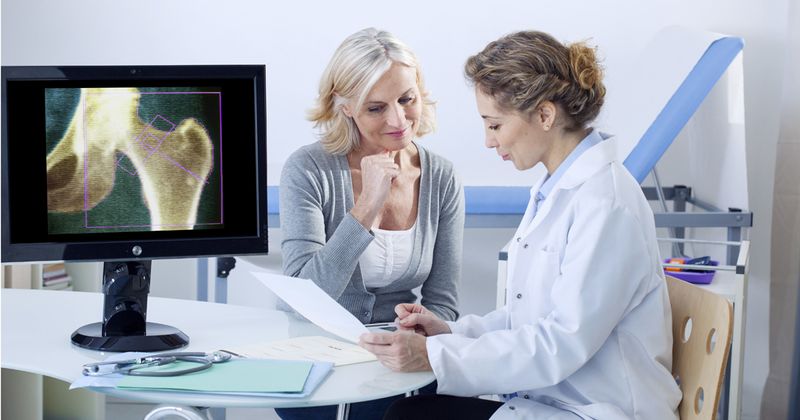Physical activity and fractures, impact of vitamin D supplements top 2021 bone news
The Healio and Endocrine Today editors have compiled the top news about bone and mineral metabolism in 2021.
Readers were most interested in learning about predictors for osteoporosis in menopause, physical activity and its role in fracture prevention during middle age, and whether vitamin D can help prevent fractures in healthy adults.

Here are 10 of Healio’s most-read stories on bone and mineral metabolism research from 2021.
Absolute appendicular lean mass best predictor of osteoporosis in menopause
Absolute appendicular lean mass may be a suitable marker for predicting osteoporosis based on low muscle mass for postmenopausal women. In a study published in Menopause, appendicular lean mass was associated with osteoporosis at the lumbar spine and the femoral neck in a cohort of postmenopausal women.
Moderate physical activity may prevent fractures for middle-aged adults
Middle-aged adults can lower their risk for fractures with moderate levels of leisure-time physical activity, according to a study published in the Journal of Bone and Mineral Research. In a prospective, population-based analysis, each increase in physical activity levels was associated with a reduction in fracture risk. By contrast, working time with a heavy workload was linked to an increased risk for fractures.
Exercise builds bone strength during menopause
Monthly risedronate therapy combined with a 12-month regimen of impact and resistance exercises was associated with greater gains in spine bone mineral density and less bone turnover in postmenopausal women with low bone mass, according to data presented at the American Society for Bone and Mineral Research virtual meeting. Exercise also led to greater increased bone strength compared with bisphosphonate therapy or calcium and vitamin D supplementation.
VITAL: No fracture risk reduction with supplemental vitamin D
Supplemental vitamin D is not associated with a reduce risk for fractures in U.S. adults without vitamin D deficiency or osteoporosis, according to an analysis of data from the VITAL trial. In a presentation at the American Society for Bone and Mineral Research virtual meeting, Meryl Susan LeBoff, MD, said while supplemental vitamin D was safe for healthy adults, it did not alter the odds for total fractures, nonvertebral fractures or hip fractures.
Vegans may have higher risk for bone fractures
Vegans have a greater risk for total fractures than meat eaters, and vegans, fish eaters and vegetarians are more likely to have hip fractures, according to a study published in BMC Medicine. In a prospective cohort study of people from the United Kingdom, the risk for hip fractures was more than twice as high for vegans compared with meat eaters, and the risk for total fractures was more than 1.4 times higher.
BMD loss seen in early adulthood for women, despite healthy behaviors
Women may begin to have bone loss as soon as 5 years after menarche, according to findings presented at the American Society for Bone and Mineral Research virtual meeting. In an analysis of longitudinal data, Jodi Dowthwaite, PhD, said women, even those who have good bone quality due to health behaviors in childhood, may begin to have bone loss in their early 20s, making it important to set up a strong peak bone mass foundation for later life.
Oral anticoagulants may lower bone density, trabecular bone score
Oral anticoagulation therapy is associated with lower BMD and trabecular bone score in adults. In a cross-sectional, observational study published in Bone, adults taking direct-acting oral anticoagulants or warfarin had lower bone mass than those in a control group.
Vitamin D level associated with COVID-19 risk for Black adults
Having a high level of vitamin D may be especially important for Black adults when it comes to COVID-19 protection. In a study published in JAMA Network Open, Black adults who had an “adequate” level of vitamin D were more likely to test positive for COVID-19 compared with those who had a high vitamin D level of at least 40 ng/mL.
Shared risk factors may drive cognitive decline and bone loss, fracture risk for women
A bidirectional relationship exists between cognitive decline and accelerated bone loss with increased fracture risk in women, according to a study published in the Journal of Bone and Mineral Research. Compared with women without cognitive function loss, participants with cognitive decline had a higher rate of bone loss during the study’s first 5 years.
Greater lumbar spine BMD, bone strength gains with romosozumab for postmenopausal women
Postmenopausal women with osteoporosis had larger improvements in BMD and bone strength at the lumbar spine after 12 months of receiving romosozumab (Evenity, Amgen) compared with those receiving only alendronate, according to findings from the ARCH trial. The romosozumab group had a 7.8% greater areal BMD gain at 6 months and 10.3% greater gain at 12 months compared with the alendronate group.
